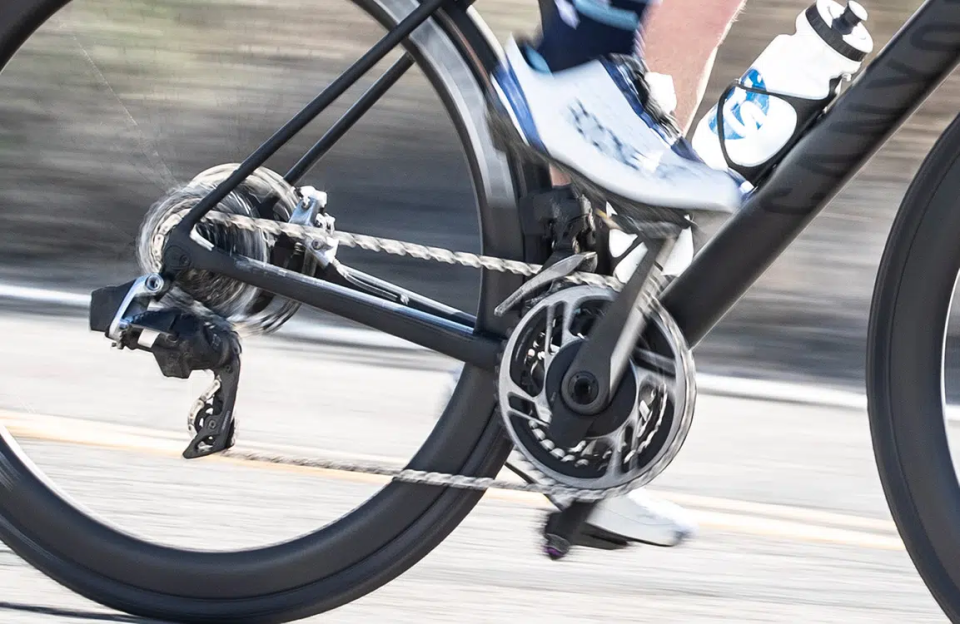Cycling Cadence: Economy, Efficiency and How to Train Low and High Cadence to Ride Faster
Pedaling is the most important skill for a cyclist to master. Yet, because most people learn to pedal as toddlers, there’s an assumption we’ve mastered it by adulthood through sheer repetition. For athletes looking to optimize performance on the bike – any type of bike – training your pedal stroke and cycling cadence are as important as training your aerobic engine

What is Cadence?
Cadence in cycling is simply how fast your pedals are going around, typically measured in revolutions per minute (rpm). A cyclist’s power output is the product of force and cadence (Power = Force x Velocity). Therefore, we can increase power output by pushing harder on the pedals (increase force), increasing cadence, or both.
Is there an ideal cadence for cycling?
The relationship between force and cadence can alter muscle function and fatigue, as well as oxygen consumption. Lower cadences shift emphasis to increased force production; skeletal muscles work harder and fatigue faster. In contrast, higher cadences shift stress to the cardiovascular system. At the same power output, pedaling faster reduces the average force during the pedal stroke but increases oxygen consumption to contract skeletal muscles more frequently. An ideal cadence would maximize power output, minimize oxygen consumption, and delay muscle fatigue. The problem is that the physiological differences between people there is no universally ideal cycling cadence.
What’s a good cycling cadence?
A mountain of research has generally concluded that most cyclists naturally gravitate to cadences between 80-100rpm. Preferred or self-selected cadence tends to increase gradually with experience and fitness. Specific cadence-focused training can lead to increased or decreased in self-selected cadence, depending on the training parameters. (Whitty et al. 2016)
Beginners often pedal slower, between 65-85rpm at endurance intensity and up hills. An underdeveloped aerobic system and lower mechanical efficiency for pedaling may be contributing factors to increased reliance on force production.
Experienced cyclists typically pedal at 75 – 95rpm during sustained efforts at recovery, aerobic endurance (Zone 2) and lactate threshold (FTP) intensities. This includes riding on flat terrain, rolling hills, and prolonged climbs.
High cadences, 95 – 110rpm, are usually reserved for high-intensity, high-power efforts and accelerations. In training, that includes VO2 max and anaerobic capacity intervals, and sprint workouts. Low-power, high-cadence drills can be utilized for neuromuscular training, improving mechanical efficiency.
Cycling Economy vs. Mechanical Efficiency
A common but oversimplified belief in cycling is that a higher cadence is better for performance. Some of this comes from the fact highly trained cyclists and elite competitors typically maintain higher cadences than beginners and amateurs.
Cycling economy refers to oxygen cost of producing a given power output. Mechanical efficiency refers to how much mechanical work results relative to the energy produced. In practical terms, we evaluate progress by looking at oxygen cost at a given power output. When you can lower the oxygen cost to produce 200 watts of power, you have improved cycling economy.
There is an instance where cycling economy decreases because of a desired physiological adaptation from endurance training. Breaking down fat to usable energy requires more oxygen than breaking down carbohydrate. Greater aerobic fitness increases fat oxidation at a given power output, which is good for sparing glycogen. It slightly decreases cycling economy, however, because the oxygen cost for producing that power output has increased.
Cadence and Cycling Economy
Lower cadence cycling can be more economical, metabolically, because there are less frequent muscle contractions. Fewer, more forceful contractions also recruit more fast-twitch muscle fibers. These fibers produce energy anaerobically, but also fatigue quickly.
Higher cadence cycling can be more costly in terms of oxygen consumption because muscles must contract more frequently. Lower force production per pedal stroke also shifts the muscle fiber recruitment to favor aerobic, more fatigue-resistant slow-twitch fibers.
Whether you break down fuel to usable energy more or less economically, only about 20-25% of that energy ends up performing mechanical work. The other 75-80% is lost as heat.
Benefits of training at different cadences
Training can improve both your cycling economy and your mechanical efficiency. On the metabolic side, muscles take in oxygen and fuel (kilocalories primarily from fat and carbohydrate) to produce energy for contractions. Endurance training improves your ability to break down fuel to usable energy and increases your body’s infrastructure for utilizing that energy for mechanical work. As cyclists become more economical, they produce the same power at a lower oxygen cost (observed outside the lab through lower heart rate).
With practice and proper bike fit to optimize biomechanics, cyclists can also improve the mechanical efficiency of their pedal stroke. Some of this comes down to joint angles, leverage, and tendon stiffness. Training – including cadence drills – stimulates neuromuscular adaptations that improve the synchronization of muscle contractions for less wasted energy.
The goal of cadence training is not to home in on an athlete’s one ideal cadence. The goal is to increase the range of cadences a cyclist can use effectively to produce power. The best cyclists have good cadence agility, meaning they can rapidly transition from high force, low cadence to lower force, higher cadence as circumstances demand.
When to use high cadence in cycling
The times to leverage high cadence include sprints, attacks, accelerations, and prolonged high-power efforts like time trials and solo breakaways. High cadence shifts the stress of hard efforts more to the aerobic system, which is more fatigue resistant than skeletal muscles. Sometimes higher performance comes at a higher metabolic cost. The point of endurance training is to increase aerobic capacity so you can pay the increased metabolic cost.
When to use low cadence in cycling
Low cadence is useful for training muscular endurance, producing high torque, and accelerating from a stop or slow speed. It can also be used to conserve energy and maintain momentum while drafting or riding in a pack.
Cadence for triathlon and different cycling disciplines
Any athlete pushing pedals benefits from extending their range of effective cadence. However, the physiological and performance demands of some cycling and triathlon disciplines favor faster or slower cadences. The ability to produce high torque is important for mountain biking, gravel racing, and cyclocross.
Triathletes – particularly long-course triathlon competitors – benefit from the lower metabolic cost of lower cadences to conserve energy for the run. (Vercruyssen et al. 2005) However, other research suggests riding the final minutes of the cycling leg at a higher cadence may improve running performance. (Gottshall et al. 2005)
High peak and average cadence are important for road and criterium racers, BMX competitors, and track racers. But it’s not just the ability to turn the pedals over quickly. Overall, producing high power at high cadence is the essential combination for winning performances.
“High cadence” is also relative. BMX riders can reach sprint cadences of 120-140rpm, which is extremely fast compared to some other disciplines. However, some research indicates that a relatively “slow” BMX cadence (100rpm) is optimal for reaching peak power output most quickly. (Rylands et al. 2017)
Workouts and drills to improve cycling cadence
Cadence drills can aim to improve pedaling mechanics, neuromuscular patterns that synchronize muscle activation, and/or muscle fiber recruitment. Low power, high cadence pedaling targets neuromuscular adaptations. On the other hand, low cadence, high resistance pedaling recruits more fast-twitch muscle fibers and more motor units within a given muscle.
High Cadence Cycling Drills
FastPedal
It’s exactly what it sounds like, the caveat is to use a light gear to keep resistance low, but not so light there’s no resistance at all. Keep your upper body calm and pedal as fast as you can without bouncing in the saddle. Start with three to five 1-minute efforts separated by two minutes of moderate-cadence recovery. Progress to 3-minute efforts with five minutes recovery between them. Your heart rate will increase, but RPE should stay at about 5 out of 10.
Tip: You already know how to push down on the pedals. To smooth out your stroke so you can move your feet faster without bouncing, think about kicking your foot forward over the top of the stroke and scraping it back through the bottom. As you improve these areas you can slightly extend the effective portion of your pedal stroke at all power levels.
High Speed Sprints
Find a downhill section of road where you can sprint safely. In a medium gear (big chainring, middle of the cassette), get rolling to about 15-20mph. In this case, you want to be going fast enough to pedal about 90rpm with only light resistance. Sprint for 20 seconds. If you spin out the gear, start in a bigger one the next time. Rest five minutes between sprints and complete 5-8.
You can do High Speed Sprints standing or seated. To be sure, seated accelerations are important in races. Standing up and swinging your bike around is a dead giveaway you’re attacking. If you can powerfully rev up your cadence while keeping your upper body calm, you may ride people off your wheel before they realize what’s going on.
Low Cadence Cycling Drills
PowerStart
At the slow end of the cadence spectrum, accelerating against a heavy resistance reinforces the mechanics – particularly the kick over the top and scrape through the bottom – that help smooth out your high cadence pedaling. They’re also great for developing high power to accelerate from slow speeds. To begin, roll to a near standstill at 2-3 mph in a big gear. Focus on keeping your core stable and preventing your back from rounding, and accelerate as powerfully as you can without changing gear. Continue for 10 seconds or until the gear is spun out, then rest five minutes between PowerStarts. Complete 5-8 repetitions.
MuscleTension Intervals
Over-geared climbing often-overlooked component of building climbing speed. During MuscleTension intervals you are pedaling slowly (about 50-55 rpm cadence) against a heavy resistance in order to recruit and engage more muscle fibers to generate the necessary force to continue climbing. These are aerobic intervals, in that your power output will be at or below Functional Threshold Power. To clarify, these are high force efforts, not necessarily high peak power efforts. Prolonged high-force intervals at an aerobic cardiovascular intensity may also lead a subset of fast-twitch (Type II) muscle fibers to change their characteristics and behave more like endurance-friendly slow-twitch (Type I) fibers.
To perform them well, you need a climb that lasts 5-10 minutes. The grade doesn’t have to be steep (although it can be); a steady 1-2% false flat will work if that’s all you have. Total time-at-intensity for a single workout should be around 20 minutes for beginners, 30 minutes for intermediate riders, and 40 for advanced riders (doesn’t need to be exact).
You can divide that total time-at-intensity a variety of ways: 3×7 minutes, 4×5 minutes, 2×15 minutes, 3×12 minutes, etc. A good starting point for beginner and intermediate riders would be 4x 5-minute MT intervals. Recovery between intervals should be equal to the duration of the efforts. For instance, you should take 6 minutes of easy spinning recovery between 6-minute MuscleTension intervals. Further, you can read an entire article on this workout.
To find out more, please visit: https://trainright.com/cycling-cadence-economy-efficiency-and-how-to-train-low-and-high-cadence-to-ride-faster/
FREE 14 DAY MEMBERSHIP TRIAL
Gran Fondo Guide fans, click on the image above and get TrainRight Membership for a 14 day no obligation trial. TrainRight Membership comes with a 30-day money-back guarantee!
About CTS
As it has since 2000, Carmichael Training Systems leads the endurance coaching industry with proven and innovative products, services, and content. And the results speak for themselves; no other coaching company produces more champions, in such a wide variety of sports and age groups, than CTS.
For more information, please visit: https://trainright.com

